![]()
![]()
![]()
Use LEFT and RIGHT arrow keys to navigate between flashcards;
Use UP and DOWN arrow keys to flip the card;
H to show hint;
A reads text to speech;
104 Cards in this Set
- Front
- Back
|
Temperature descriptor for: Pseudomonas fluorescens
|
mesophile
|
|
|
Temperature descriptor for: Bacillus stearothermophilus
|
mesophile
|
|
|
Temperature descriptor for: Serratia marcescens
|
Thermophile
|
|
|
Temperature descriptor for: Saccharomyces cervisiae
|
mesophile
|
|
|
Temp range for: psychrophiles
|
-5 -15 C
|
|
|
Temp range for: mesophiles
|
20 - 45 C
|
|
|
Temp range for: thermophiles
|
45 - 70 C
|
|
|
Antibiosis - def'n
|
biological interaction between two or more organisms that is detrimental to at least one of them
|
|
|
Antibotic testing outcomes
|
1. Sensitive
2. Resistant |
|
|
Sensitive, in terms of antibiotic testing
|
Limited growth
|
|
|
Resistant, in terms of antibiotic testing
|
No growth allowed
|
|
|
Spectrum of antibiotic resistance:
|
Broad
Narrow Limited |
|
|
Broad Resistance - def'n
|
Kills or inhibits a wide range of bacteria. e.g., gram ⊖ & ⊕ bacteria
|
|
|
Narrow Resistance - def'n
|
Kills either Gram - or +, not both
|
|
|
Limited resistance - def'n
|
Effective against a particular organism
|
|
|
Rhizobium - def'n
|
Nitrogen-fixing bacteria found in the nodules of plants
|
|
|
Azotobacter - desc
|
Motile, oval or spherical bacteria, aerobic, free-living soil microbes which play an important role in the nitrogen cycle
|
|
|
Enterobacteriae Media tests - list
|
Glucose broth
Lactose broth Clark & Lubbs SIM Tubes Nitrate Broth Citrate slant |
|
|
Enterobacteriaceae - desc
|
rod-shaped, have Gram-negative stains, and they are facultative anaerobes, fermenting sugars to produce lactic acid and various other end products. Most also reduce nitrate to nitrite
|
|
|
YEPD - desc
|
Yeast Extract Peptone Dextrose is a complete medium for yeast growth
|
|
|
TSB Media - desc
|
Tryptic Soy Broth. For bacteria
|
|
|
Kirby-Bauer disk diffusion technique - desc
|
Determines a bacterias resistant/sensitvity to an antibiotic by measuring the Z.O.I (Zone of inhibition)
|
|
|
Nitrogen fixing bacteria convert ___ to ___
|
Nitrogen fixing bacteria convert N2_ to _NH3_
|
|
|
OPNG - desc
|
Analog of lactose; yellow color
|
|
|
Operon - desc
|
Set of genes regulated by one promoter
|
|
|
The lac operon is ________ when ____ is low
|
The lac operon is _induced_ when _glucose_ is low
|
|
|
Enzyme induction via lac operon can be found in ___________
|
Enzyme induction via lac operon can be found in _E. coli_
|
|
|
Enterobacteriaceae family ferment _____ to _____
|
Enterobacteriaceae family ferment _glucose_ to _pyruvate_
|
|
|
β-galactosidase
|
intracellular enzyme that cleaves the disaccharide lactose into glucose and galactose
|
|
|
Operation of an operon can be _____ or _____
|
Operation of an operon can be _induced_ or _repressed_
|
|
|
Mixed Acid Pathways - list
|
Lactic Acid
Acetic Acid Formic Acid Succinate Ethanol |
|
|
By-products of Mixed Acid Pathways - list
|
CO₂ & H₂
|
|
|
Bacteria that make use of mixed-acid pathways - list
|
Coliforms:
E. coli Shigella Salmonella Klebsiella |
|
|
Bacteria that make use of 2,3 butanediol pathway - list
|
non-coliforms:
Enterobacter Serratia Erwinia |
|
|
Fecal enterics/Coliforms - pathogenicity
|
not good
|
|
|
non-Fecal enterics/non-Coliforms - pathogenicity
|
good!
|
|
|
Fecal enterics/coliforms - list
|
E. coli
Shigella salmonella Klebsiella |
|
|
NON-Fecal enterics/NON-coliforms - list
|
Enterobacter
Serratia Erwinia |
|
|
Clarks & Lubbs media - tests
|
Glucose fermentation
|
|
|
Methyl Red - Purpose
|
Identifies Mixed acid fermentation of glucose
|
|
|
Methyl red: + Result
|
Turns red
|
|
|
Methyl red: medium
|
Clark & Lubbs
|
|
|
Voges-Proskauer: medium
|
Clark & Lubbs
|
|
|
Voges-Proskauer: + Result
|
Pink/Red color
|
|
|
Voges-Proskauer: Purpose
|
Reacts with acetoin
|
|
|
Nitrate Reduction test: medium
|
nitrate broth
|
|
|
Nitrate Reduction test: desc
|
Add nitrate I & II. If no pink color, add zinc.
Tests for enterobactiace |
|
|
Nitrate Reduction test: + Results
|
Pink: NO -> NO2
Pink when Zinc added: Zinc reduced NO |
|
|
Starch utilization test: + results
|
Clear area around the bacterial streak
|
|
|
Indole Production test: purpose
|
tests if species can turn tryptophan into pyruvate, which can then be broken down to indole
|
|
|
Hydrogen sulfide test: + Result
|
Blackening of medium
|
|
|
Indole Production- medium
|
SIM
|
|
|
Indole Production: reagent
|
Kovac's reagent
|
|
|
Indole Production: + Result
|
Red color
|
|
|
Citrate utilization test: medium
|
Citrate broth
|
|
|
Citrate utilization test: + Result
|
turbidity
|
|
|
Citrate slant test: + Result
|
Turned blue; citrate used
growth; ammonia broken down |
|
|
EMB Plate - Purpose
|
Isolates fecal coliforms. Lactose/sucrose selective for fermenters (coliforms), dyes inhibit Gram-positive bacteria
|
|
|
EMB Plate: + Result
|
Pink: fermentation, little acid: Possible coliform
Dark Purple & Green: Fermentation & lots of acid: Probable coliform Growth, no color: No fermentation: non-coliform |
|
|
HEK Plate - Selective/Differential?
|
Selective & Differential
|
|
|
EMB Plate: Selective/Differential?
|
Selective & Differential
|
|
|
HEK Plate - How differential?
|
Isolates enteric species, salmonella, shigella
|
|
|
HEK Plate - How selective?
|
Inhibits Gram +
|
|
|
HEK Plate - differentiates between . . .
|
fermenters & non-fermenters
|
|
|
HEK Plate Fermenters: List
|
Enterobacter
E. Coli |
|
|
HEK Plate Non-Fermenters: List
|
Proteus
Salmonella Shigella |
|
|
MacConkey Plates: Selective/Differential?
|
Selective & Differential
|
|
|
Starch Plates: Selective/Differential?
|
Selective
|
|
|
MacConkey Plate: How selective?
|
Selects for Gram -; Salts inhibit Gram +
|
|
|
MacConkey Plate: How differential?
|
Detects lactose fermenters
|
|
|
MacConkey Plate: + Result
|
Pink/red = Fermentation
|
|
|
Starch Plate: Purpose
|
Tests for starch hydrolysis
Added iodine turns starch brown. Clear zone means starch was hydrolyzed: + |
|
|
Citrate Slant - Selective/Differential?
|
Selective & Differential
|
|
|
Citrate Slant - Results
|
Blue + Growth - citrate used ( pH increases as ammonia broken down)
Growth only: Citrate Used No Growth - Citrate NOT used |
|
|
Citrate Slant test - Purpose
|
Tests for ability of bacteria to use citrate as carbon source, differentiates among enterobacteriacae
|
|
|
MacConkey Agar test - Purpose
|
Isolates and Differentiates members of enterobacteriaceae on he ability to ferment lactose
|
|
|
HEK Plate - Purpose
|
Isolates and differentiates salmonella & shigella from other gram-negative enteric organisms
|
|
|
Nitrate Reduction Test - Purpose
|
Detects species that can reduce nitrate to nitrite
|
|
|
Durham tube - desc
|
Traps gas evolved from respiration
|
|
|
Voges-Proskauer test - Purpose
|
Identifies organisms able to produce acetoin from the breakdown of glucose during a 2,3-butanediol fermentation
|
|
|
Acetoin
|
used as an external energy store by a number of fermentive bacteria
|
|
|
Cyanobacteria - Desc
|
Large class of photosynthetic bacteria that use H₂O
|
|
|
Cyanobacteria - Characteristics
|
Slimy coating
Phycobilins Varied cell shape Some fix nitrogen Gram ⊖ Gram - |
|
|
Phycobilin
|
Accessory pigments in cyanobacteria that absorb light
|
|
|
Lactic Acid Bacteria - Characteristics
|
Gram ⊕
Catalase ⊖ |
|
|
Homolactic
|
Only waste product is Lactic Acid
|
|
|
Heterolactic
|
Lactic Acid is produced as waste, as well as Some gas byproduct
|
|
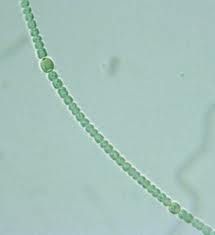
Name it!
Is it a cyanobacteria or algae? |
anabaena
cyanobacteria |
|
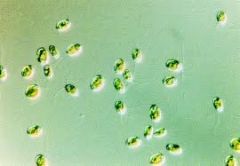
Name it!
Is it a cyanobacteria or algae? |
chlamydomonas
alga |
|
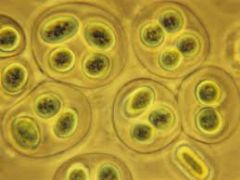
Name it!
Is it a cyanobacteria or algae? |
gloeocapsa
cyanobacteria |
|
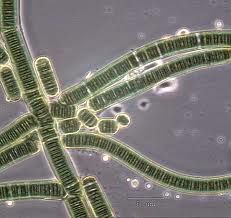
Name it!
Is it a cyanobacteria or algae? |
lyngbya
cyanobacteria |
|
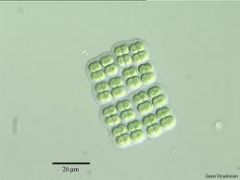
Name it!
Is it a cyanobacteria or algae? |
merismopedia
cyanobacteria |
|
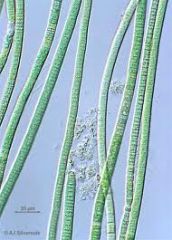
Name it!
Is it a cyanobacteria or algae? |
oscillatoria
cyanobacteria |
|
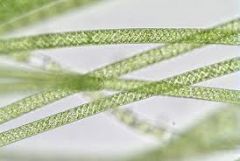
Name it!
Is it a cyanobacteria or algae? |
spirogyra
algae |
|
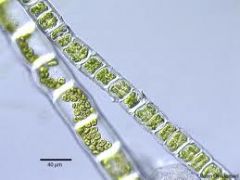
Name it!
Is it a cyanobacteria or algae? |
ulothrix
algae |
|

Name it!
Is it a cyanobacteria or algae? |
volvox
algae |
|
|
Formula for calculating pfu
|
# plaques
------------------------------------------- volume plated * dilution factor |
|
|
coliform - def'n
|
pertaining to the colon-aerogenes group, or the Escherichia coli species of microorganisms, which comprises most of the intestinal flora in humans and other animals. Presence of coliforms is used as a standard indication of water pollution with fecal matter.
|
|
|
Enteric bacteria - def'n
|
in the family Enterobacteriaceae. These bacteria reside normally in the guts of many animals, including humans, and some are pathogenic, causing disease in certain animal species. Many cases of food poisoning are caused by infection with enteric bacteria
|
|
|
Glucose & Lactose broth: + results
|
red & bubbles - Mixed acids fermenter
red, NO bubbles - 2,3 butanediol pathway yellow: peptone breakdown amber: no reaction |
|
|
Acetoin
|
Used as an external energy store by a number of fermentive bacteria
|
|
|
Motility stab: Purpose
|
Tests for motility
|
|
|
Motility stab: + Result
|
Outward red growth
|
|
|
Hydrogen Sulfide test: Purpose
|
Checks for Enteric gram negative bacilli by checking for the enzyme thiosulfate reductase which is produced by various intestinal microorganisms. So if bacillus subtilis can produce this enzyme then this test will give you a pos. (black in color) result.
|

